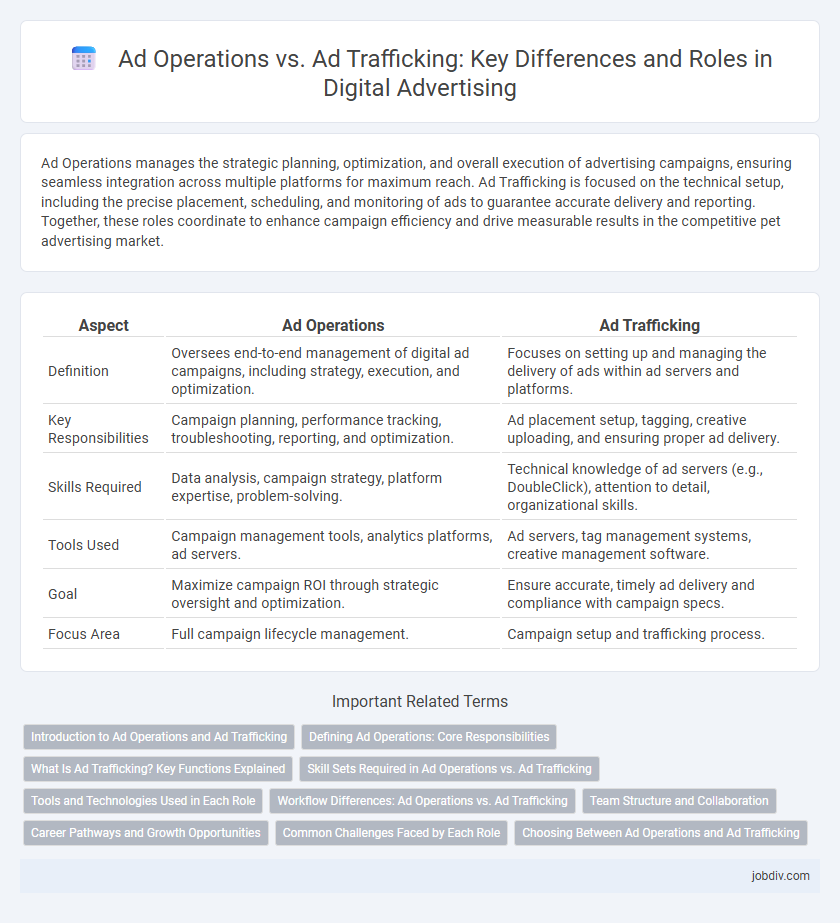Ad Operations manages the strategic planning, optimization, and overall execution of advertising campaigns, ensuring seamless integration across multiple platforms for maximum reach. Ad Trafficking is focused on the technical setup, including the precise placement, scheduling, and monitoring of ads to guarantee accurate delivery and reporting. Together, these roles coordinate to enhance campaign efficiency and drive measurable results in the competitive pet advertising market.
Table of Comparison
| Aspect | Ad Operations | Ad Trafficking |
|---|---|---|
| Definition | Oversees end-to-end management of digital ad campaigns, including strategy, execution, and optimization. | Focuses on setting up and managing the delivery of ads within ad servers and platforms. |
| Key Responsibilities | Campaign planning, performance tracking, troubleshooting, reporting, and optimization. | Ad placement setup, tagging, creative uploading, and ensuring proper ad delivery. |
| Skills Required | Data analysis, campaign strategy, platform expertise, problem-solving. | Technical knowledge of ad servers (e.g., DoubleClick), attention to detail, organizational skills. |
| Tools Used | Campaign management tools, analytics platforms, ad servers. | Ad servers, tag management systems, creative management software. |
| Goal | Maximize campaign ROI through strategic oversight and optimization. | Ensure accurate, timely ad delivery and compliance with campaign specs. |
| Focus Area | Full campaign lifecycle management. | Campaign setup and trafficking process. |
Introduction to Ad Operations and Ad Trafficking
Ad Operations involves the strategic management and execution of digital advertising campaigns, ensuring proper ad delivery, targeting, and performance optimization across multiple platforms. Ad Trafficking is a subset of Ad Operations focused on the technical setup and scheduling of ads within ad servers, guaranteeing accurate campaign deployment and compliance with advertiser specifications. Both functions collaborate to maximize campaign efficiency and deliver measurable results in programmatic and direct advertising environments.
Defining Ad Operations: Core Responsibilities
Ad Operations encompasses the strategic management and execution of digital advertising campaigns, ensuring optimal delivery, targeting, and performance tracking across platforms. Core responsibilities include campaign setup, inventory management, troubleshooting technical issues, and optimizing ad placements to maximize ROI. This function integrates data analysis and coordination with media buying and creative teams to streamline ad delivery and maintain campaign integrity.
What Is Ad Trafficking? Key Functions Explained
Ad trafficking involves the precise management and delivery of digital advertisements across various platforms, ensuring that campaigns run smoothly within specified parameters. Key functions include setting up ad campaigns in ad servers, monitoring ad placements, and troubleshooting delivery issues to maximize performance and adherence to targeting criteria. This process is crucial for accurate reporting and optimizing real-time campaign adjustments in digital advertising operations.
Skill Sets Required in Ad Operations vs. Ad Trafficking
Ad Operations demands advanced skills in campaign strategy, data analysis, and troubleshooting complex platform integrations, whereas Ad Trafficking focuses on precision in ad placement, schedule management, and quality assurance. Mastery of programmatic platforms, real-time bidding systems, and performance optimization is crucial for Ad Operations professionals, while Ad Traffickers require expertise in tag management, trafficking software, and compliance monitoring. Both roles benefit from strong attention to detail and communication skills, but Ad Operations emphasizes analytical problem-solving and strategic planning more intensely.
Tools and Technologies Used in Each Role
Ad Operations professionals utilize comprehensive platforms such as Google Ad Manager, Sizmek, and DoubleClick to manage campaign analytics, optimize bidding strategies, and ensure seamless ad delivery. Ad Traffickers primarily work with tools like ad servers, tag management systems, and Excel sheets for manual trafficking, tag implementation, and quality assurance. While Ad Operations focuses on programmatic technologies and automation software, Ad Trafficking emphasizes hands-on execution through specialized trafficking and verification tools.
Workflow Differences: Ad Operations vs. Ad Trafficking
Ad Operations encompasses the end-to-end management of digital advertising campaigns, including strategy, trafficking, optimization, and reporting, whereas Ad Trafficking primarily focuses on the technical setup and delivery of creative assets within ad servers. The workflow in Ad Operations involves cross-team coordination, campaign performance analysis, and troubleshooting, while Ad Trafficking centers on tagging, scheduling, and ensuring correct ad placements according to campaign specifications. Clear distinction between these roles enhances efficiency by aligning strategic management with precise technical execution in advertising campaigns.
Team Structure and Collaboration
Ad Operations oversees the end-to-end management of digital advertising campaigns, including strategy, execution, and performance analysis, while Ad Trafficking focuses specifically on the accurate setup and trafficking of ad creatives and tags within ad servers. In team structures, Ad Operations managers coordinate cross-functional teams such as sales, creative, and analytics, ensuring seamless workflow, whereas Ad Traffickers operate as specialized roles within these teams, handling detailed technical tasks. Collaboration between these functions is critical to optimize campaign delivery, troubleshoot issues quickly, and maximize advertising ROI through precise targeting and reporting.
Career Pathways and Growth Opportunities
Ad Operations encompasses managing and optimizing entire advertising campaigns, offering broader career pathways including strategy, analytics, and leadership roles. Ad Trafficking focuses on the technical setup and delivery of ads, serving as a foundational role with growth potential into operations and campaign management. Professionals starting in Ad Trafficking often advance to Ad Operations positions, gaining skills that unlock diverse opportunities in digital advertising and programmatic media.
Common Challenges Faced by Each Role
Ad Operations professionals often face challenges in campaign optimization and technology integration, ensuring seamless delivery across multiple platforms and managing complex data analytics. Ad Trafficking specialists struggle with accurate ad placement, timely creative updates, and coordinating between creative, sales, and technical teams to prevent trafficking errors. Both roles encounter difficulties in maintaining real-time performance tracking and adapting to evolving advertising technologies and compliance regulations.
Choosing Between Ad Operations and Ad Trafficking
Choosing between Ad Operations and Ad Trafficking depends on the scope of responsibilities and strategic impact desired. Ad Operations encompasses end-to-end campaign management, optimization, and technical troubleshooting, while Ad Trafficking focuses primarily on the precise setup and delivery of ads. Organizations aiming for broader control over digital advertising strategy typically prioritize Ad Operations for its comprehensive oversight.
Ad Operations vs Ad Trafficking Infographic

 jobdiv.com
jobdiv.com